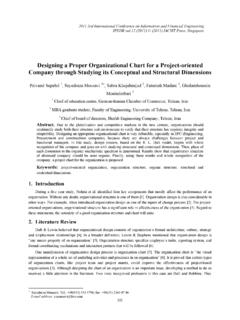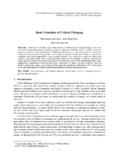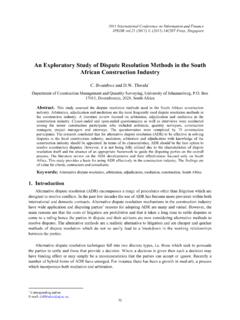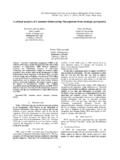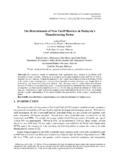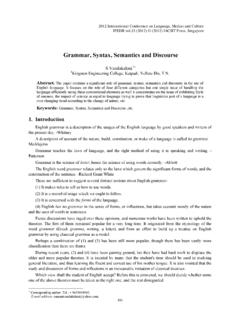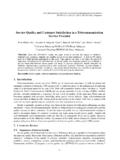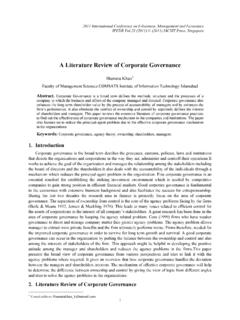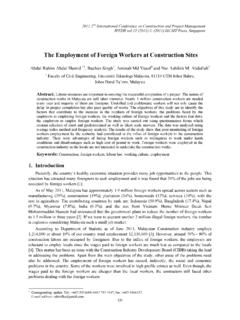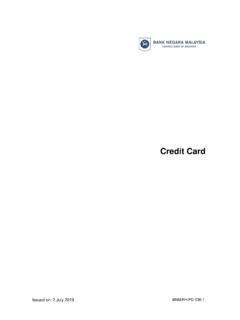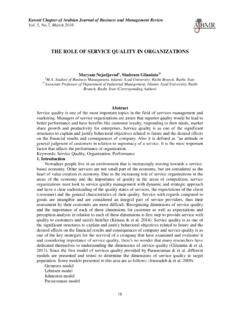Transcription of Macroeconomic Theories of Inflation - IPEDR
1 Macroeconomic Theories of Inflation Jalil Totonchi islamic Azad University, Yazd Branch, Department of Economics, Yazd, Iran Abstract -- The study of causes of Inflation has probably given rise to one of the most significant Macroeconomic debates in the field of economics. In practice; however, it is not always easy to decompose the observed Inflation into its monetary, demand-pull, cost-push and structural components. The process is dynamic, and the shocks to prices are mixed. Furthermore, Inflation itself may also cause future Inflation . This paper, mainly attempts to review and analyze the competing and complementary Theories of Inflation .
2 The theoretical survey in this research work yielded a six-blocked schematization of origins of Inflation ; monetary shocks, Demand side, supply-side (or real) shocks, structural and political factors (or the role of institutions). It appeared that Inflation is the net result of sophisticated dynamic interactions of these six groups of explanatory factors. That is to say, Inflation is always and everywhere a Macroeconomic and institutional phenomenon. Key Words- Inflation , Macroeconomic Theory I. INTRODUCTION The study of causes of Inflation has probably given rise to one of the most significant Macroeconomic debates in the field of economics.
3 The debates differ in their hypotheses, mainly due to a range of conventional views about the appropriate measure to control Inflation and also due to disparity between developed and developing countries. In general, the cause of Inflation in developed countries is broadly identified as growth of money supply. In developing countries, in contrast, Inflation is not a purely monetary phenomenon. Beside, factors typically related to fiscal imbalances such as higher money growth and exchange rate depreciation arising from a balance of payments crisis dominate the Inflation process in developing countries, as discussed by Sergent & Wallace [1] and Montiel [2].
4 This paper, mainly attempts to review and analyze the competing and complementary Theories of Inflation . II. THE QUANTITY THEORY OF MONEY The quantity theory of money is one of the oldest surviving economic doctrines. Simply stated, it asserts that changes in the general level of general prices are determined primarily by changes in the quantity of money in circulation. The quantity theory of money formed the central core of 19th century classical monetary analysis, provided the dominant conceptual framework for interpret in contemporary financial events and formed the intellectual foundation of orthodox policy prescription designed to preserve the gold standard.
5 David Hume (1711-76) provided the first dynamic process analysis of how the impact of a monetary change spread from one sector of the economy to another, altering relative price and quantity in the process. He provided considerable refinement, elaboration and extension to the quantity theory of money David Ricardo (1772-1823), the most influential of the classical economists, thought such disequilibrium effects ephemeral and unimportant in long-run equilibrium analysis. As leader of the Balloonists, Ricardo charged that Inflation in Britain was solely the result of the Bank of England's irresponsible over issue of money, when in 1797, under the stress of the Napoleonic Wars; Britain left the gold standard for an inconvertible paper standard.
6 Ricardo discouraged discussions on possible beneficial output and employment effects of monetary injection [3]. Irving Fisher (1876-1947) spelled out his famous equation of exchange viz. MV=PT. This and other equations, such as the Cambridge cash balance equation, which corresponds with the emerging use of mathematics in neo-economic analysis, define precisely the conditions under which the proportional postulate is valid. Fisher and other neo-classical economists, such as Arthur Cecil Pigou (1877-1959) of Cambridge, demonstrated that monetary control could be achieved in a fractional reserve-banking regime via control of an exogenously determined stock of high power money.
7 III. MONETARY THEORY OF Inflation Monetarism [4] refers to the followers of M. Friedman (1912-2006) who hold that only money matters , and as such monetary policy is a more potent instrument than fiscal policy in economic stabilization. According to the monetarists, the money supply is the dominate, though not exclusive determinant of both the level of output and prices in the short run, and of the level of prices in the long run. The long- run level of output is not influenced by the money supply [5]. The monetarists emphasized the role of money. Modern quantity theory led by Milton Friedman holds that Inflation is always and everywhere a monetary phenomenon that arises from a more rapid expansion in the quantity of money than in total output.
8 Its earliest explanation was to be found in the simple quantity theory of money. The monetarists employed the familiar identity of exchange equation of Fisher. IV. DEMAND PULL THEORY John Maynard Keynes (1883-1946) and his followers emphasized the increase in aggregate demand as the source of demand-pull Inflation . The aggregate demand comprises consumption, investment and government expenditure. 4592011 International Conference on Economics and Finance Research IPEDR (2011) (2011)IACSIT Press, Singapore When the value of aggregate demand exceeds the value of aggregate supply at the full employment level, the inflationary gap arises.
9 The larger the gap between aggregate demand and aggregate supply, the more rapid is the Inflation . Keynesian (Keynes and his followers)do not deny this fact that even before reaching full employment production factors and various appearing constraint can cause increase in public price. This Inflation constraint that appears quickly during prosperity is originally resulting from non-proportioned section, branches and or various economic resources that are accounted from natural properties of discipline based on market. Therefore, in one period of prosperity it is completely natural. According to demand-pull Inflation theory of Keynes, policy that causes decrease in each component of total demand is effective in reduction of pressure demand and Inflation .
10 One of the reductions in government expenditure is tax increase and to control volume of money alone or together, can be effective in reducing effective demand and Inflation control. In difficult conditions, hyperinflation during war that control of volume of money or decrease in general expenditure may not be practical increase in tax can get along with direct action for control on demand [6]. V. COST PUSH THEORY Cost-push Inflation is caused by wage increases enforced by unions and profit increases by employers. The type of Inflation has not been a new phenomenon and was found even during the medieval period. But it was reviewed in the 1950s and again in the 1970s as the principal cause of Inflation .

